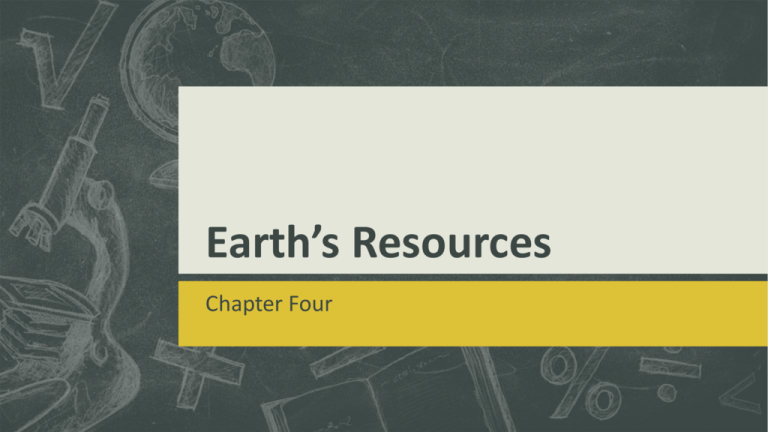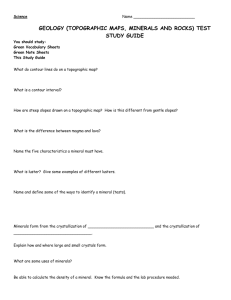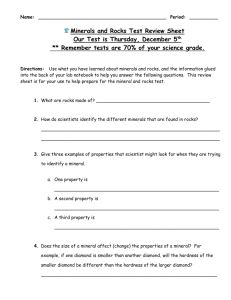Minerals & Rocks
advertisement

Earth’s Resources Chapter Four Lesson One: Minerals & Rocks Objectives • Compare and contrast properties of minerals. • Describe how three main kinds of rocks form. Read Science books page 202 & do review page 203 Minerals and Rocks Vocabulary: Lesson 1 Luster- The property of a mineral that describes how light reflects from the mineral. Sediment- Tiny bits of animals, plants, or weathered rock. Mineral- A solid, nonliving substance found in nature. Sedimentary Rock- formed when layers of sediment pile up and are pressed together. Metamorphic Rock- Formed deep inside the Earth. Heated and squeezed by the weight of rocks above. Igneous Rock- Formed when melted rock is cooled and hardened either inside Earth or on Earth’s surface. What are minerals? A mineral is a solid, nonliving substance found in nature. Salt, gold, and iron are minerals. The graphite in your pencil is a mineral!!! Minerals are the building blocks of rocks. Minerals are found underground and in soil. They are even in the ocean and on the ocean floor. There are more than 3,000 different kinds of minerals. Each mineral has its own properties. You can use the properties of minerals to tell them apart. Color Turquoise Feldspar Quartz It is easy to observe a mineral’s color. Most minerals come in just one color. However, some, like quartz, come in many colors. Some, like gold and pyrite, are the same color. You cannot use color alone to identify a mineral. Streak Streak is another property used to identify minerals. Streak is the color of the powder left when a mineral is rubbed across a white tile. A mineral’s streak may or may not be the same as the mineral’s color. Luster Luster describes how light bounces off a mineral. Some minerals are shiny like metal. Others are not. Luster is another property used to identify a mineral. Hardness The hardness of a mineral describes how easily it can be scratched. Some minerals, like talc and gypsum, are soft. They can be scratched with a fingernail. Other minerals, like quartz, are much harder. Not even a steel file can scratch quartz. Pyrite may look like gold, but its streak is different. Pyrite’s streak is greenishblack. Gold’s streak is yellow. Mica can have a pearly luster. Diamond is the hardest mineral. No other mineral or object can scratch it. How can hardness be used to identify minerals? Mohs’ hardness scale shows the hardness of a few common minerals. There are many more minerals for each level of hardness. Diamond, 10 on the scale, is the hardest mineral. Talc, 1 on the scale, is one of the softest minerals. Minerals with higher numbers can scratch minerals with lower numbers. For example, quartz can scratch any mineral with a hardness that is less than 7. Quartz, however, can itself be scratched by a mineral with a hardness that is greater than 7. What are rocks? A rock is a nonliving material made of one or more minerals. There are hundreds of different types of rocks. Some rocks, like granite, are made of several minerals. Some rocks, like limestone, are made mostly of one mineral. A rock’s color gives clues about the minerals that make it up. Grains Rocks are made of mineral pieces called grains. To a person who studies rocks, a rock’s texture is how its grains look. Some rocks have large grains you can easily see. These rocks have a coarse texture. Some rocks have grains that are too small to see. These rocks have a fine texture. Igneous Rocks Rocks are classified by how they form. There are three kinds of rocks-igneous, sedimentary, and metamorphic. An igneous rock forms when melted rock cools and hardens. Inside Earth, melted rock called magma cools and hardens very slowly. A rock with large mineral grains forms. Melted rock that flows onto Earth’s surface is called lava. Lava cools and hardens quickly. A rock with small mineral grains forms. What are sedimentary and metamorphic rocks? Sediment is tiny bits of weathered rock or once-living animals or plants. Sedimentary rock is a kind of rock that forms from layers of sediment. Sedimentary rocks form where weathered and eroded materials are dropped. This often happens at the bottom of rivers, lakes, and oceans. Over time, sediment piles up. The top layers press on layers below. In time the sediment becomes cemented together and forms rock. What are sedimentary and metamorphic rocks? A rock that has been changed by heating and squeezing is a metamorphic rock. Deep inside Earth, rocks heat up and “bake.” They also get squeezed by the weight of the rocks above them. All this heating and squeezing can cause a rock’s minerals to change into new minerals. A new rock forms with properties that are different from the original rock. Shale is a sedimentary rock made up of bits of weathered materials. Gneiss is a metamorphic rock. It forms from granite. Fossils are often found in the sedimentary rock limestone. Limestone can form from the remains of onceliving things. Slate is a metamorphic rock. It forms from shale. Sandstone is sedimentary rock that forms from tiny particles of sand . Phyllite is a metamorphic rock. It forms from the metamorphic rock slate.







